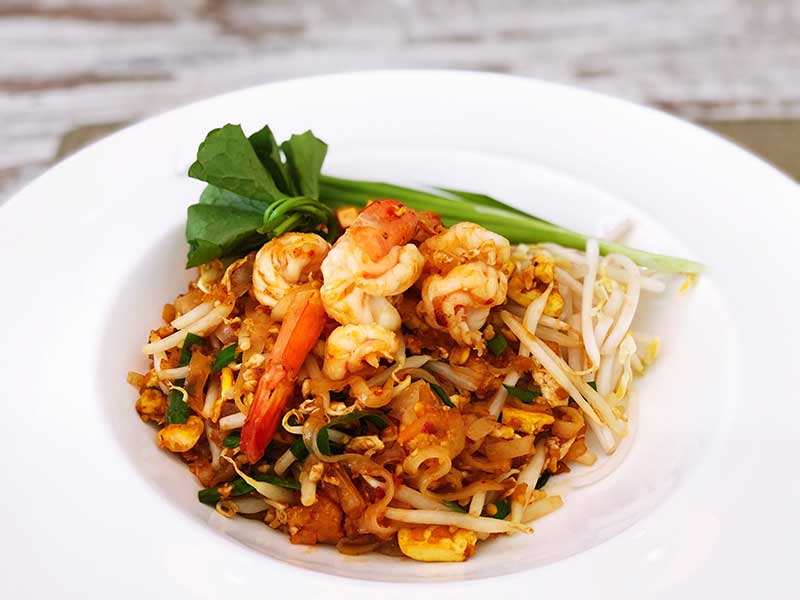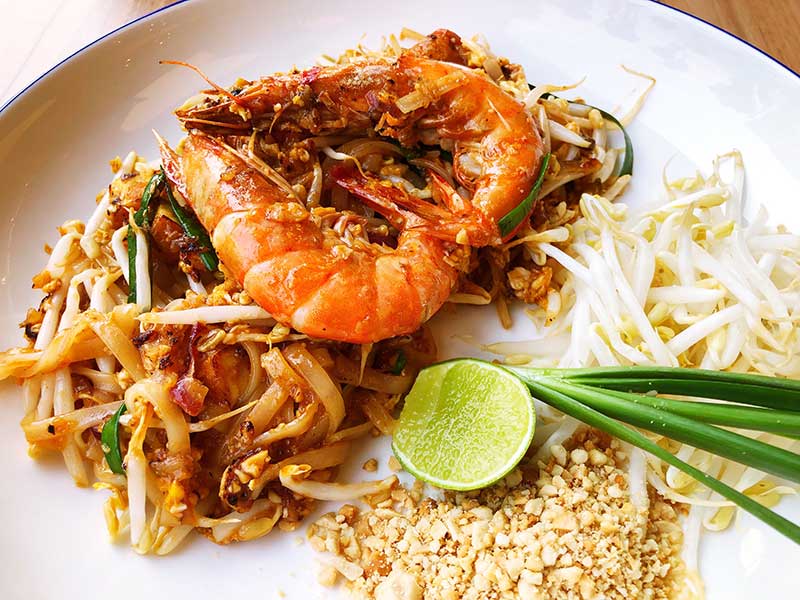Pad Thai is a popular type of noodle meal that is traditionally prepared in Thailand and involves stir-frying the noodles. Rice noodles, eggs, tofu, shrimp or chicken, bean sprouts, peanuts, and various seasonings such fish sauce, tamarind, and palm sugar are the basic components of this dish. It may also include palm sugar.
Pad Thai is a meal that is frequently considered to be a classic example of Thai cuisine and is frequently found on the menus of Thai restaurants located all over the world. It is also a common item found on the streets of Thailand, where it is frequently cooked freshly and sold by vendors on the street.
Pad Thai is a dish that may be prepared in a wide variety of ways, and some parts of Thailand might even have their own special take on the dish. In some preparations, more vegetables or meat may be included, while in others, the level of heat or sweetness may vary according on the items that are utilized.
Overall, Pad Thai is a food that is flavorful and gratifying, and it has gained popularity around the world due to the fact that it can be prepared in a variety of ways and has excellent flavor.
Here’s a simple recipe for Pad Thai that serves 2-3 people:
Ingredients:
- 8 oz dried rice noodles
- 2 tablespoons vegetable oil
- 3 cloves garlic, minced
- 1/2 cup sliced chicken or shrimp (or both)
- 2 eggs
- 2 tablespoons fish sauce
- 2 tablespoons tamarind paste
- 2 tablespoons palm sugar
- 1 cup bean sprouts
- 2 tablespoons chopped peanuts
- 2 green onions, sliced
- Lime wedges, for serving
- Cilantro, for garnish

Instructions:
- Soak the rice noodles in warm water for about 20 minutes until they become pliable but not too soft. Drain and set aside.
- In a wok or large skillet, heat the oil over medium-high heat. Add the garlic and cook for 30 seconds until fragrant.
- Add the chicken or shrimp to the wok and stir-fry until cooked through, about 3-4 minutes.
- Push the chicken or shrimp to one side of the wok and crack the eggs into the other side. Scramble the eggs until they are cooked, and then mix them in with the chicken or shrimp.
- Add the drained noodles to the wok, along with the fish sauce, tamarind paste, and palm sugar. Stir-fry everything together until the noodles are coated with the sauce and everything is heated through.
- Add the bean sprouts and stir-fry for another minute until they are slightly cooked but still crunchy.
- Sprinkle the chopped peanuts and green onions over the top of the dish and serve with lime wedges on the side. Garnish with cilantro.
Enjoy your homemade Pad Thai!
Here are some tips to make delicious Pad Thai:
- Use the right noodles: Pad Thai is typically made with rice noodles, which come in different thicknesses. For best results, use medium-thick noodles, which will hold up better during cooking and won’t break apart too easily.
- Soak the noodles properly: Soaking the noodles in warm water is an important step that helps soften them up before cooking. Be sure to soak the noodles for the recommended time in the recipe, and don’t over-soak them or they will become too soft and mushy.
- Prep all ingredients beforehand: Pad Thai cooks quickly, so it’s important to have all ingredients chopped and ready to go before you start cooking.
- Cook in batches: When cooking Pad Thai, it’s important to cook in batches rather than all at once. This helps ensure that each ingredient is cooked properly and doesn’t become overcooked or burnt.
- Adjust seasoning to your taste: The amount of fish sauce, tamarind paste, and palm sugar needed may vary depending on personal preference. Taste the dish as you go and adjust the seasoning accordingly.
- Don’t overcook the bean sprouts: Bean sprouts should be added towards the end of the cooking process to ensure they remain crunchy and don’t get too soft.
- Serve with lime wedges: Squeezing fresh lime juice over Pad Thai just before serving adds a bright, citrusy flavor that helps balance the sweetness and saltiness of the dish.
Remember, practice makes perfect when it comes to cooking Pad Thai. With a little bit of patience and experimentation, you’ll be able to create a delicious Pad Thai that’s perfect for your taste buds.

